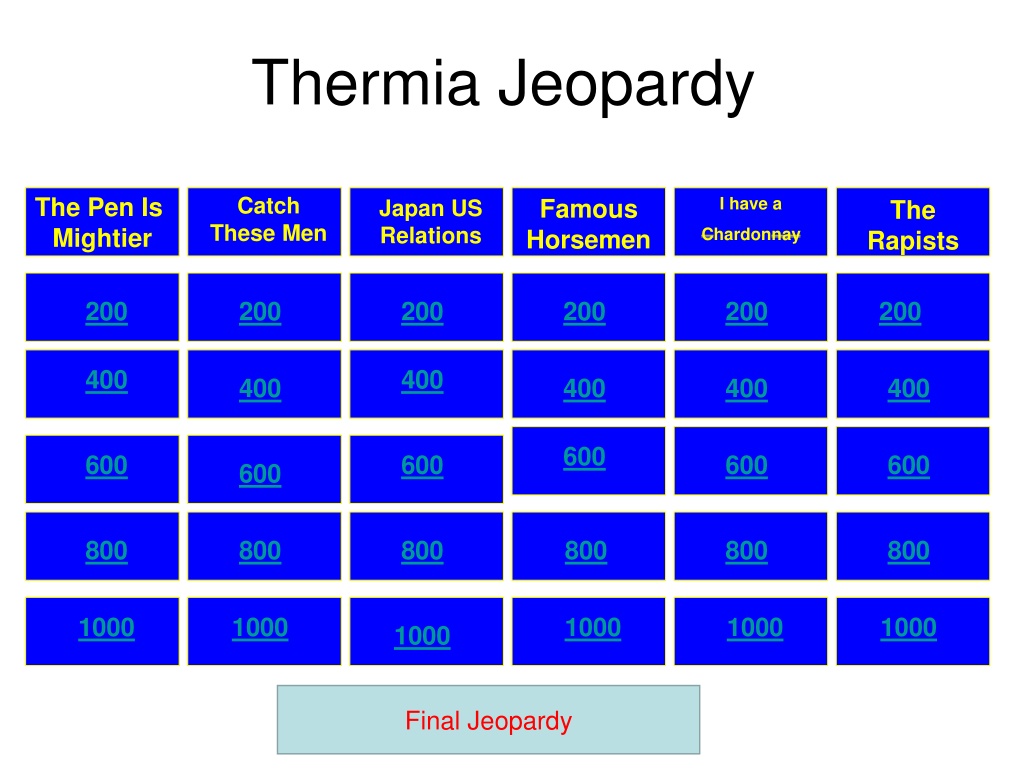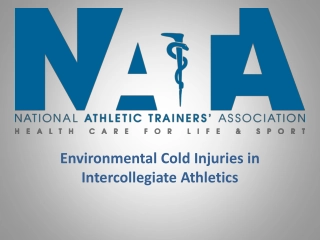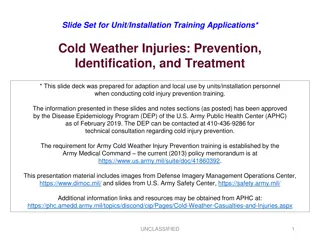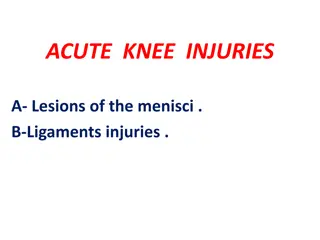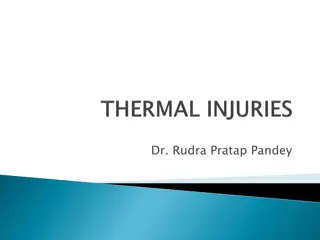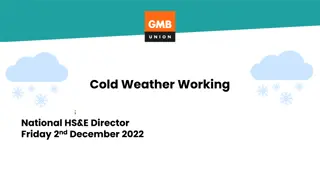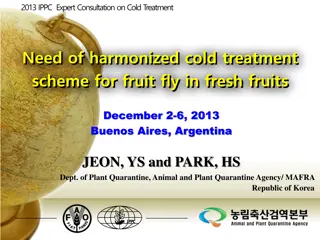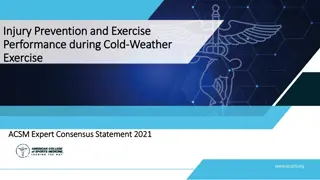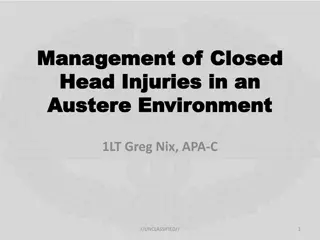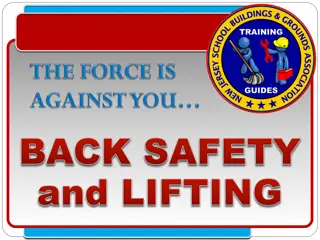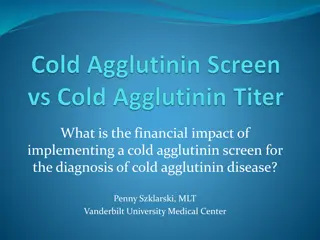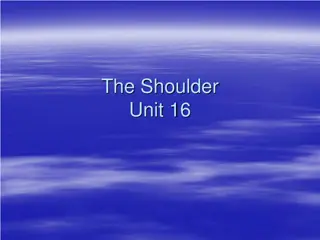Cold-Related Injuries and Conditions Overview
Explore the definition, presentation, and treatment of non-freezing cold-related injuries like trench foot, chillblains, panniculitis, and cold urticaria. Learn about the characteristics, observations, and diagnosis of these conditions and understand the risks associated with frostbite in specific age and gender groups.
Download Presentation

Please find below an Image/Link to download the presentation.
The content on the website is provided AS IS for your information and personal use only. It may not be sold, licensed, or shared on other websites without obtaining consent from the author.If you encounter any issues during the download, it is possible that the publisher has removed the file from their server.
You are allowed to download the files provided on this website for personal or commercial use, subject to the condition that they are used lawfully. All files are the property of their respective owners.
The content on the website is provided AS IS for your information and personal use only. It may not be sold, licensed, or shared on other websites without obtaining consent from the author.
E N D
Presentation Transcript
Thermia Jeopardy The Pen Is Mightier Catch These Men I have a Famous Horsemen The Rapists Japan US Relations Chardonnay 200 200 200 200 200 200 200 200 200 200 200 400 400 400 400 400 400 400 400 400 400 400 400 600 600 600 600 600 600 600 600 600 600 600 600 800 800 800 800 800 800 800 800 800 800 800 1000 1000 1000 1000 1000 1000 1000 1000 1000 1000 1000 1000 Final Jeopardy
What is the definition of a non-freezing cold related injury and what are the types? Exposure to wet conditions when temperatures are > freezing Trench foot, chilblains/pernio, panniculitis, cold urticaria
What is the presentation and treatment of trench foot? Pale, mottled, anesthetic, pulseless, immobile -> Hypermia -> bullae -> sloughing Supportive treatment Consider vasodilators, oral prostaglandins (may improve circulation), clean, warm, dry bandaged, elevated
What is characterized by the following? Chillblains/pernio inflammatory lesions of the skin caused by long-term intermittent exposure to damp, nonfreezing ambient temperatures localized edema, erythema, cyanosis, plaques, nodules, and, in rare cases, ulcerations, vesicles, and bullae Tingling and numbness
This is observed on the cheeks, thighs and buttocks of patients, often in children or young women of equestrian background. What is panniculitis? Popsicle panniculitis
A young female complains that every time she goes in the cold, she feels her throat is closing and she is itchy. What is the most likely diagnosis? Malingering (Cold urticaria)
What are the 3 most common areas of frostbite in order? Head, hands, feet
These ages and gender combinations are the highest at risk for frostbite Teenage males Young males in the military
This is the temperature and wind speed at which rate of cold injuries starts to increase 12 deg C (10.4 deg F) Wind speed > 4.5 m/s (10 mph)
The depth of freezing depends on the following three elements Temperature Duration of exposure Velocity of freezing
These are the three zones of frostbite injury. Zone of coagulation Zone of hyperemia Zone of stasis
These are the degrees of frostbite injury and what they mean.
These are all of the appropriate frostbite treatment steps in the ED Rapid rewardming in hot water (100 deg) Clear blisters? Ppx abx? Aloe vera topical cream q6hours Dry gauze Thrombolysis? NSAIDS Methimazole? Steroids?
These are risk factors for hypothermia Burns Iatrogenic Impaired shivering Young Old Malnourished Medications (etoh, beta blockers, sedatives, vasodilators) Metabolic disorders Sepsis Shock Trauma
These are the stages and temperatures of hypothermia. Stage 1 35-32 Stage 2 32 28 Stage 3 - < 28 Stage 4 cardiac arrest
These are the treatments for a patient in moderate hypothermia with a temperature of 30. Active external warming, minimally invasive rewarming (warm environment, heating packs, hot air, warmed fluids, warm blankets) Full body insulation, immobilization Minimal, cautious movements Core temperature monitoring
These are the indications for ECMO or CPB in hypothermia. Cardiac arrest Hemodynamic instability refractory to medical management Co-morbid patients who are unlikely to tolerate the low cardiac output associated with severe hypothermia
If ECMO/CPB unavailable for hypothermia, these measures may save an arrested patient s life. Thoracic Lavage Bladder Lavage Peritoneal Lavage Gastric Lavage Rectal Lavage
If your hypothermic patient is in cardiac arrest, this is the most appropriate management. Rewarming CPR May be reasonable to use vasopressors (AHA) Up to 3 defib attempts, withhold epinephrine until core temp is > 30, double the frequency of administration until temp > 35 (ERC) CPR and up to 3 doses of epinephrine and defibrillation (Tintinalli s)
These are the methods for the body to dissipate heat and how they work Radiation electromagnetic transfer from warm to cool Conduction heat exchange between two surfaces Convection heat transfer from air or liquid moving across an object Evaporation heat loss by vaporization of water or sweat
These are the physiologic response to heat stress. Vasodilation Increased sweat production Decreased heat production Behavioral heat control
These are some of the medications that make patients more susceptible to heat injury. Anticholinergic Diuretics Beta blockers Calcium channel blockers Sympathomimetic agents Phenothiazines Alcohol
This is classic heat injury, exertional heat injury and confinement hyperpyrexia. Classic heat injury high environmental heat stress Exertional heat injury athletic events or jobs under conditions of stress Confinement hyperpyrexia children inside cars
Orthostatic pooling of interstitial fluid in gravity dependent extremities due to cutaneous vasodilation is known as this. Heat edema
This is the pathogensis of heat cramps Deficiency of sodium, potassium or magnesium and fluid at he muscle level.
A 22 year old who has been working outside is complaining of headache, nausea, vomiting, malaise, dizziness, and muscle cramps. He is tachycardic and his temperature is 103.5 deg F. This is his diagnosis. Heat Stress
Patients suffering from heat stress require these treatment methods Oral electrolytes 1 2L IVF cooled or room temperature Removal from hot environment Removal of clothing Fans
These two features are required for the diagnosis of heat stroke. Hyperthermia > 40 deg C/104 deg F Altered mental status
These are the initial resuscitation measures for heat stroke and the heat loss mechanism they utilize. Removal from environment and remove clothing Spray patient with water and fans Wet towels or sheets Ice Room temperature IVF
This treatment method has been found to be very effective for cooling and was originally developed for athletes. Immersion Cooling
In patients with refractory hyperthermia, you should consider the following treatments. CPB Cold Water Gastric Lavage Urinary bladder lavage Rectal lavage ?peritoneal lavagae
DAILY DOUBLE Avoid cooling less than this temperature to avoid overshoot hypothermia. 102.2 deg F
FINAL JEAPORDY Complete this famous SNL quote Alex Trebec: "The category is "rhymes with dog," and the question is, "It's been a Hard Day's night and I should be sleeping like a ................"
